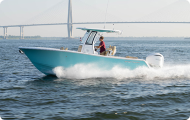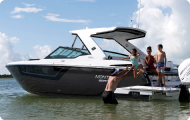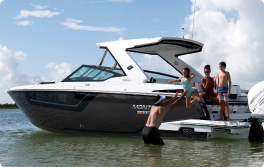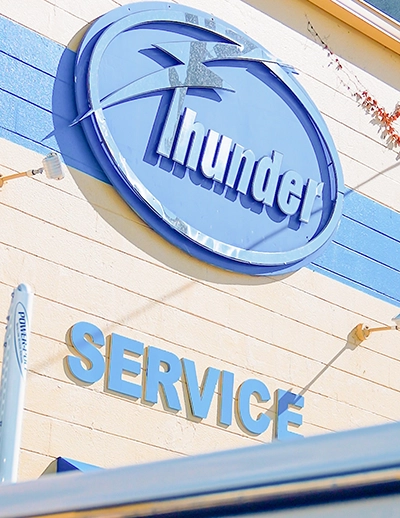Successfully launching a boat for the first time is an exciting experience for any new boat owner. After you learn how to properly launch a boat, you’ll be able to trailer that boat and explore any body of water serviced by a ramp.
10 Steps for Launching a Boat
- In a staging area, check that the drain plug is installed and the key is in the ignition.
- Load all your gear into the boat—fishing tackle, coolers, tubes, skis, etc.
- Attach fenders to the dock side of the boat and remove the transom tie-down straps.
- Attach dock lines to the bow and stern cleats.
- Unplug the trailer lights from the tow vehicle to keep cold water from damaging the hot bulbs.
- Then, move your tow vehicle in position to back straight down the ramp.
- Reverse down the ramp slowly, so you have time to correct if needed.
- Back down the ramp until you see the stern of the boat start to float.
- Put your vehicle in park with the parking brake, and release the trailer winch and safety chain.
- Use a bow line, give the boat a little push, and slide it slowly off the trailer to float in the water.
Pro Tip: As you check that your drain plug is installed and your key is in the ignition, this would be a good time to bump the key into the “start” position just to make sure you don’t have a dead battery. Better to find out now than after the boat is off the trailer. Don’t start the engine! You’ll damage the water pump.
Prepping Your Boat Prior to Launch
If you are brand new to launching from a ramp it might be helpful to make your first attempt on a weekday or a least a day when the ramp is not going to be too busy just so you don’t feel pressured to do everything in a hurry. Launch ramps may be public—at a county park, for example—or private, such as a ramp at a private campground, gated community, or marina. In either case there may be a small fee for launching, so take care of that as soon as you arrive.
If you’ve never used a particular ramp it can be helpful to park out of the way and walk down to inspect the ramp and dock. This way you’ll know how steep the ramp is, how deep the water seems to be, and the condition of the dock. This way you can make a plan before the boat is wet. You can also observe the flow of traffic around the ramp, and decide where to park the vehicle and trailer after you launch.
It’s etiquette at a public ramp to be as efficient as possible when launching. With that in mind, you want to prepare your boat to launch as soon as it touches the water. Park in a staging area out of the way of others who are actually launching.
Tips for Backing Down the Ramp
Once you’re ready to back down the ramp and launch, you’ll want to align the boat and trailer so you can back straight down the ramp.
- If you’ve got a helper along have them spot for you—the helper should be positioned so you can see them in your left-hand mirror.
- Back slowly. This gives you more reaction time to correct the trailer if it starts to go crooked. A good trick is to place one hand at the bottom of the steering wheel and then watch the trailer in your mirrors. If you want the trailer to go left in your mirror, move you hand to the left, or to the right to steer the trailer to the right in your mirror.
- Back down the ramp until the trailer tires touch the water and then see if the stern of the boat is deep enough to start to float. If not, back down a little more until that happens.
Getting Your Boat Off the Trailer
With your vehicle in park and the parking brake set, get out and remove the safety chain from the bow eye, and release the trailer winch so the strap goes slack and you can unclip it from the bow eye. Your helper can also do this while you wait in the vehicle, but you still should put the vehicle in Park and set the brake.
Depending on the ramp and your tow vehicle, you may or may not be able to release the boat without standing in the water. It’s best to wear footwear that can get wet, or boots.
- Hand the bow line to your helper (and the stern line if it will reach) and give the boat a little push. It should float and slide off the trailer. If not, you’ll need to back in a little further.
- Your helper can now hold the lines and walk it down the dock until the boat is clear of the trailer. If the helper also holds the stern line the boat won’t swing out into the launch area.
- Walk the boat as far down the dock as possible to get out of the way of the next party waiting to launch. If your helper is able to operate the boat (or park the vehicle and trailer) an alternate plan is for one person to be in the boat as it’s backed down the ramp.
- Lower the outdrive or outboard after the boat is in the water and start the engine before releasing the bow eye.
- Now you can float the boat off the trailer and your helper can power the boat out of the way of the busy ramp and pick you up at the dock after the vehicle is parked.
Using this method you’ll know before you release the boat that the engine will start. As soon as the boat is free, move the vehicle and trailer out of the way, park and return to the dock and the boat.
How to Launch a Boat by Yourself
Launching a boat by yourself follows the same routine up to the point of releasing the boat. If there’s a dock at the ramp, it will usually help to back the trailer down as close to the dock as possible.
You are going to want to have a line ready to secure the boat after it floats off the trailer, and there are several ways to do this. The best method depends on the ramp.
Method #1
The first method is to attach a single line to both the bow and the stern cleat.
- Back down the ramp and push the boat off the trailer while holding the line.
- Once the boat is free use the trailer as a step and hop onto the dock.
- Now with the single line you can control the boat—the stern can’t swing away from the dock—and walk the boat down the dock and out of the way of the trailer and others waiting to use the ramp.
- Secure the boat to the dock, park the vehicle and you’re ready to go.
This method works when the dock is low and easy to reach. If that’s not the case, you’ll need a longer line.
Method #2
- Secure one end to the middle (spring) cleat on the boat and, after backing down but before releasing the boat.
- Secure the other end to a cleat or piling as far down the dock as possible.
- Now back down a little further if necessary, release the boat and then hop on the dock to pull the boat away from the trailer and then secure it to the dock.
Method #3
- Secure a long line (about 25 feet) to the bow cleat, coil the line and place it on the bow of the boat, and then tie the other end to the trailer.
- Now back down and release the boat or just let it float off the trailer.
- Next drive up the ramp a few feet, park and go back to the trailer.
- Untie the line and because you’ve got plenty of length you should be able to walk over to the dock and pull the boat up to the dock and secure it.
























